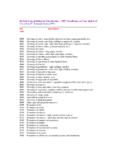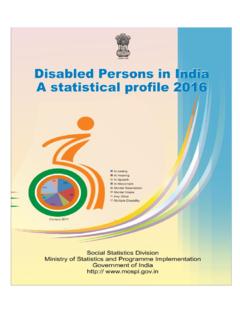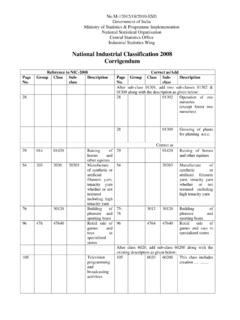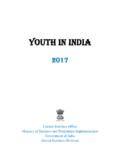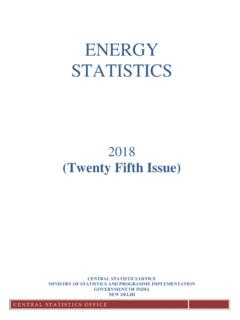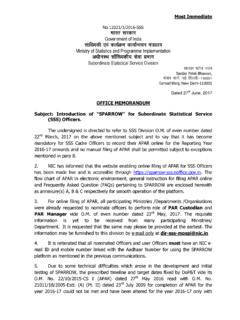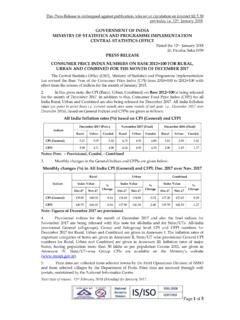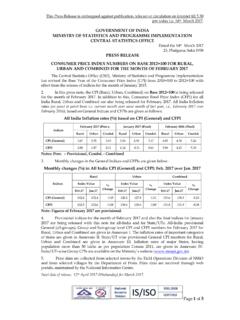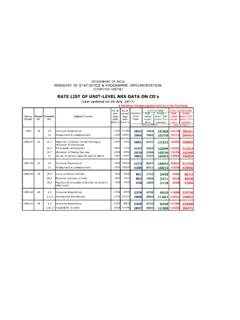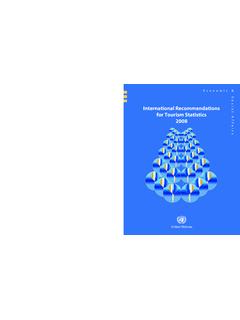Transcription of National - mospi
1 National Industrial classification [All Economic Activities). 2008. Central statistical Organisation Ministry of Statistics and Programme Implementation Government of India New Delhi India Preface The Central statistical Organisation of the Ministry of Statistics and Programme Implementation being nodal statistical authority is vested with the responsibility of setting up standards for collection, compilation and dissemination of statistical data. The official statistical data are required to be collected and presented according to classification designed to facilitate their use for National economic policy and for international comparison.]
2 Comparability of statistics available from various sources, on different aspects of the economy, and usability of such data for economic analysis are prerequisite for standardization of a system of classification . 2. The Central statistical Organisation (CSO), which is responsible for coordination of statistical activities in the country as well as for evolving and maintaining statistical standards took up the task of evolving a standard industrial classification as early as in 1960 and evolved a Standard Industrial classification (SIC) in 1962. To take care of the significant changes in the organization and structure of industries, the necessity to revise the industrial classification has been felt from time to time.
3 With this objective, the CSO revised SIC 1962 in 1970 (NIC-70), NIC-1970 in 1987 (NIC-87) and NIC-87. in 1998 (NIC-98). It is during 1998, 4-digit of ISIC-3 was folled in toto in NIC-1998 and these 4-digits were extended up to 5-digits based on National needs. After release of the United Nations International Standard Industrial classification (ISIC) - 2002 Rev. , NIC-1998 was updated keeping consistent with ISIC Rev and the updated version, namely NIC-2004 was adopted. 3. The United National statistical Commission considered the draft ISIC revision-4 during the 38th session of UNSC for adoption by all the member countries in the year 2008.
4 The SCIS of the Ministry set up an expert committee under the Chairmanship of Dr. Nath, DG (CSO) on Three meetings of the Steering Committee were held on , , respectively and in the 3rd meeting the draft NIC 2008 was approved by the Committee CSO (IS Wing), Kolkata accomplished this task of revision NIC-2004 consistent with draft ISIC Revision-4 under the leaderhip of Shri Sarker, DDG. 4. I would like to place on record my appreciation for the efforts made by the officers of CSO (IS. Wing) namely Shri Debasish Sarkar, Director, Shri G. Punjabi, Joint Director and Shri Soumya Chakraborty, Dy.
5 Director, Shri Jhulan Kar, DDG, FOD (EZ). Smt. Mita Roy Chowdhary, DDG, DPD, Shri Atanushasan Basu, Director, SDRD deserve especial thanks for going into the details of the draft and making necessary changes. Shri Vijay Kumar, ADG of Economic Statistics Division of CSO was responsible for monitoring the entire work. 5. Improvement of classification and their updation is an on going task and I would urge the users to follow NIC-2008 extensively and send comments/observations based on the experience of use, which would go a long way to improve the future classification . September, 2008 (Dr.)
6 Nath). New Delhi Director General, CSO. Officials Associated With Preparation of National Industrial classification -2008. Shri Jhulan Kar, DDG, FOD (EZ), NSSO. Smt. Mita Roychowdhury, DDG, SDRD, NSSO. Shri Paritosh Chandra Sarker, DDG, CSO (IS Wing). Shri Atanushasan Basu, Director, SDRD, NSSO. Shri Debasish Sarkar, Director, CSO (IS Wing). Shri Ghanshyam Panjabi, Joint Director, CSO (IS Wing). Shri Soumya Chakraborty, Deputy Director, CSO (IS Wing). Shri Sanjib Basu, Deputy Director, CSO (IS Wing). Shri P. K. Gupta, Ex-DPA, CSO (IS Wing). Shri , DPA, CSO (IS Wing). Shri Kalyan Sarkar, Stenographer, CSO (IS Wing).
7 National Industrial classification - 2008. (NIC-2008). Contents Page Part - I. Introduction 2. Part-II. Structure Broad Structure 13. Detailed Structure 26. Part-III. Concordance Tables Concordance between 4-digit industry classes of nic-2008 and nic-2004 129. part-IV. explanatory notes 143. Part-I. Introduction Introduction 1. A statistical system must be capable of measuring the contribution of all the economic activities towards the National wealth and be responsive to the needs of the planners to critically evaluate the steps necessary for planned development. Such measurements should also provide comparable estimates over time between regions and allow for corrective steps to achieve the goal of maximum benefit to the entire society.
8 The official statistical data have to be collected and presented according to classifications designed to facilitate their use for National economic policy and for international comparison. 2. The National Industrial classification (NIC) is an essential statistical Standard for developing and maintaining comparable data base according to economic activities. Such classifications are frequently used in classifying the economically active population, statistics of industrial production and distribution, the different fields of labour statistics and other economic data such as National income.
9 Comparability of statistics available from various sources, on different aspects of the economy, and usability of such data for economic analysis, are prerequisite for standardization of a system of classification . International Scenario 3. The issue of standardization of industrial classification at the international level was deliberated in the First International Conference of Labour Statisticians (ICLS) as early as 1923, wherein International Labour Organisation (ILO) prepared a report summarizing the classifications in use in different countries and enunciating the principles concerning industrial classification .
10 It recommended the classification of economic activity under three broad categories viz., (I) primary production (agriculture and mining);. (II) secondary production (manufacturing and construction) ; and (III) services (transport, commerce, administration, etc.). 4. The matter received further consideration at the Second (1925) and Third (1926). Conferences as a result of which a provisional list of the principal branches of economic activity was prepared mainly to help compilation of labour statistics in a comparable manner. The Committee of statistical Experts of the League of Nations to whom the whole question was subsequently referred recommended in 1938 two lists of industrial groups a minimum list and a more detailed list for classification of the gainfully occupied population.
